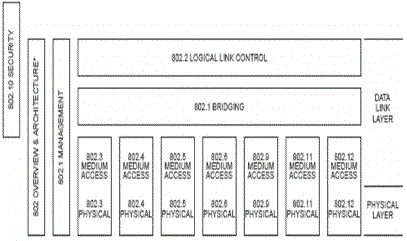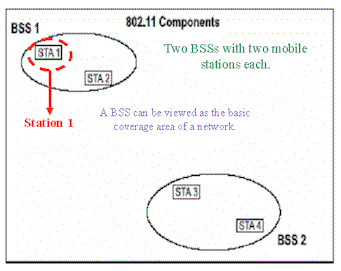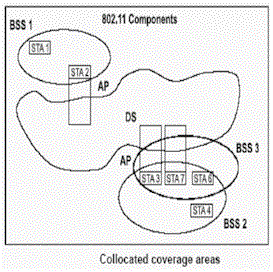|
Introduction
Under the denomination “WiFi Networks”, where WiFi
comes from Wireless Fidelity, we group a variety of wireless local
area networks which are based on the IEEE 802.11 standards.
IEEE 802.11 Standard
The first version of the IEEE 802.11 standard was
ratified in 1997 and then in 1999, when the first revisions where
made. IEEE standards are organized in such a way that extensions to
any given standard are published as modifitions and are named by
adding a letter to the original standard. In the case of 802.11, we
have extensions 802.11a, 802.11b, etc. See the references for further
information on these revisions. Actually, 802.11 is only a part of
larger set of standards: IEEE 802. Figure 1 (copied from [1]) shows
the structure of the IEEE 802 set of standards, concerned with the
lowest layers of the network architecture.

Figure 1
The lowest layer is the Physical Layer in Figure 1.
This is the logical layer in charge of defining the physical details
of the networks, say, transmitted power, modulation scheme, etc. The
physical layer is just below the Media Access Control (MAC Layer).
This layer enables the coordination of the use of the shared
transmission medium among all stations which want to communicate. In
the seven-layer OSI model, it is hte lowest sublayer of the Data Link
Layer. Uno de los componentes más conocidos es el estándar 802.3,
correspondiente a la especificación de redes de área local (LAN)
Ethernet. El éxito de 802.3 hizo que éste se convierta en una de las
principales fuentes de las cuales toma el diseño del estándar IEEE
802.11.
Industrial Standards
Besides the IEEE 802.11 standard, there are several
standards published by asociations of companies. Although industrial
standards tend to follow IEEE 802.11, it often happens that market
pressure pushes the industry to incorporate performance improvements
before they can be translated into a revision of the corresponding
IEEE standard. One of the best known associations of companies is the
Wi-Fi Alliance (see http://www.wi-fi.org). Some of its members are
Cisco, IBM, Intel Nokia, 3Com, Hewlett Packard, AMD, NEC. Avaya, Apple,
Motorota and Microsoft. These names give an idea of the relevance of
the association.
Mobile stations and basic networks
In this section we introduce some of the basic
nomenclature of WiFi networks which will be used in the remaining of
these course notes. We shall call mobile station or simple station to
any equipment connected to a wireless network. The basic structure of
a wireless network is denominated BSS, Basic Service Set. A BSS can be
seen as the minimal structure in which a group of mobile stations
which are interconnected can be organized. Also, as a first (not
completly accurate) approximation to the problem, we can view a BSS as
the coverage area network of mobile stations, that is, the area which
can be reached by radiofrequency waves transmitted by any station.
Figure 2 (modified from an illustration in [1]) shows two BSSs with
two mobile stations each.

Figure 2
Infrastructure
There are two different types of networks: 1.
Infrastructure networks: In this case, each BSS is organized around an
specialized mobile station which can grant access to a another network,
say, a wired LAN. The specialized station is called an access point
and we shall refer to it as an AP. 2. Independent (ad hoc) networks:
They are networks made up of a single BSS, called IBSS (Independent
BSS), which is not structure around any specialized station. On the
contrary, coordination tasks are equally distributed among all mobile
stations in the network. Several BSSs in an infrastructure network can
be group to be part of a larger network, known as an Extended Service
Set (ESS). An ESS is simply a network made up of a set of BSSs where
the access points act as bridges between the the BSSs. The network
which connects the access points (which could be a wired LAN such as
Ethernet) is called the Distribution System (DS). On the other hand,
the access medium in any given BSS is called a Wireless Distribution
System (WDS). Figure 3 (taken with some modifications, from [1]),
represents theses concepts schematically.

Figure 3
Overlapping networks
Although we have referred to BSSs as if they were
well-defined areas, this is an oversimplification of reality. On one
hand, BSSs are not trully “areas”, but complex volumes whose actual
shape depends on the peculiarities of the transmission of
radiofrequency waves. On the other hand, coverage regions of the BSSs
are not well-defined either and a mobile station may be inside the
coverage regions of, say, two access points, as it is shown in Figure
4 (copied from [1]).

Figure 4
Pablo I. Fierens PhD
Centro Avanzado de Comunicaciones
(Center for Advanced Studies in Communications (CAT))
Buenos Aires Institute of Technology (ITBA)
References
[1] ANSI/IEEE 802.11. Information technology-Telecommunications
and information exchange between systems-Local and metropolitan area
networks-Specific requirements-Part 11: Wireless LAN Medium Access
Control (MAC) and Physical Layer (PHY) Specifications. 1999. Available
online at http://standards.ieee.org/getieee802/.
[2] IEEE 802.11a. Supplement to IEEE Standard for
Information technology. Telecommunications and information exchange
between systems-Local and metropolitan area networks-Specific
requirements-Part 11: Wireless LAN Medium Access Control (MAC) and
Physical Layer (PHY) specifications. High-speed Physical Layer in the
5 GHz Band Adopted by the ISO/IEC and redesignated as ISO/IEC
8802-11:1999/Amd 1:2000(E). 2000. Available online at http://standards.ieee.org/getieee802/.
[3] IEEE 802.11b. Supplement to IEEE Standard for
Information technology-Telecommunications and information exchange
between systems-Local and metropolitan area networks-Specific
requirements-Part 11: Wireless LAN Medium Access Control (MAC) and
Physical Layer (PHY) specifications: Higher-Speed Physical Layer
Extension in the 2.4 GHz Band. 1999. Available online at http://standards.ieee.org/getieee802/.
[4] IEEE 802.11b. IEEE Standard for Information
technology-Telecommunications and information exchange between systems-Local
and metropolitan area networks-Specific requirements-Part 11: Wireless
LAN Medium Access Control (MAC) and Physical Layer (PHY)
specifications. Amendment 2: Higher-speed Physical Layer (PHY)
extension in the 2.4 GHz band-Corrigendum 1. 2001. Available online at
http://standards.ieee.org/getieee802/.
[5] IEEE 802.11g. IEEE Standard for Information
technology-Telecommunications and information exchange between systems-Local
and metropolitan area networks-Specific requirements-Part 11: Wireless
LAN Medium Access Control (MAC) and Physical Layer (PHY)
specifications. Amendment 4: Further Higher Data Rate Extension in the
2.4 GHz Band. 2003. Available online at http://standards.ieee.org/getieee802/.
[6] Matthew S. Gast, 802.11 Wireless Networks. The
Definitive Guide, O’Reilly, 2002.
|
Additional Information:
This article is part of the material of the course Wi-Fi
Networks. CITEL will offer 15 scholarships of the registration fee
for this course that will be offered,
10 July to 11 August,
2006 by the Buenos Aires Institute of Technology (ITBA),
through the platform of the Center of
Excellence for the Americas of the International Telecommunication
Union. These scholarships are subject to
the availability of funds corresponding to the 2006 regular
budget.
|
|

